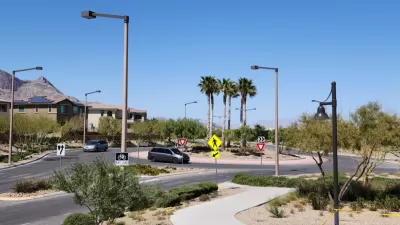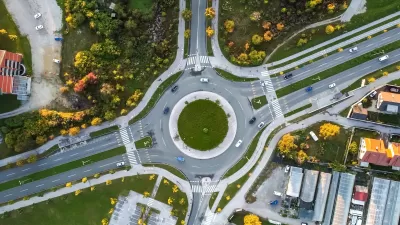They're safer, faster, require less fuel use and enhance public space. So why do Americans tend to reject proposals for roundabouts?
Americans tend to reject roundabouts for a number of reasons, including being unaccustomed to predicting other drivers' behaviors and a preference for traffic signals.
But Tom Vanderbilt argues that Americans need to get over their bias for roundabouts, and lays out out several reasons why they're far superior to regular binary intersections.
"There are few silver bullets when it comes to traffic, and roundabouts will not work everywhere. (Some intersections are already too busy to consider switching to the roundabout model.) Like anything, they can be poorly designed: You don't want them to look as if someone simply traced 'a circle around a coffee can' on a piece of paper, as one engineer has put it. Yes, there will perhaps have to be some minor educational outreach-one Indiana town is weighing spending $24,000 to do just that-but a larger question here is whether people who cannot manage to merge at low speed into a counter-clockwise circle and, yes, perhaps even change lanes in that circle, before finding the correct exit should actually be holding licenses that enable them to operate heavy machinery in the first place."
FULL STORY: Don't Be So Square

Planetizen Federal Action Tracker
A weekly monitor of how Trump’s orders and actions are impacting planners and planning in America.

San Francisco's School District Spent $105M To Build Affordable Housing for Teachers — And That's Just the Beginning
SFUSD joins a growing list of school districts using their land holdings to address housing affordability challenges faced by their own employees.

The Tiny, Adorable $7,000 Car Turning Japan Onto EVs
The single seat Mibot charges from a regular plug as quickly as an iPad, and is about half the price of an average EV.

Seattle's Plan for Adopting Driverless Cars
Equity, safety, accessibility and affordability are front of mind as the city prepares for robotaxis and other autonomous vehicles.

As Trump Phases Out FEMA, Is It Time to Flee the Floodplains?
With less federal funding available for disaster relief efforts, the need to relocate at-risk communities is more urgent than ever.

With Protected Lanes, 460% More People Commute by Bike
For those needing more ammo, more data proving what we already knew is here.
Urban Design for Planners 1: Software Tools
This six-course series explores essential urban design concepts using open source software and equips planners with the tools they need to participate fully in the urban design process.
Planning for Universal Design
Learn the tools for implementing Universal Design in planning regulations.
Smith Gee Studio
City of Charlotte
City of Camden Redevelopment Agency
City of Astoria
Transportation Research & Education Center (TREC) at Portland State University
US High Speed Rail Association
City of Camden Redevelopment Agency
Municipality of Princeton (NJ)





























